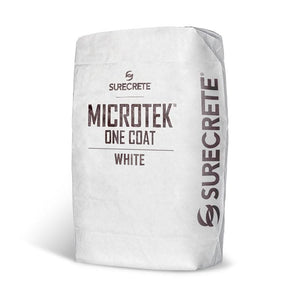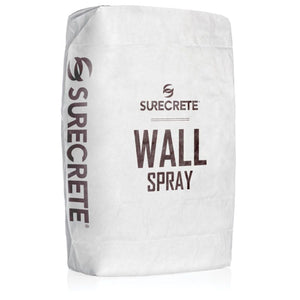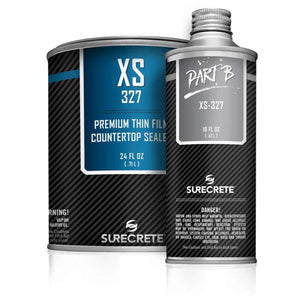SureCrete ElastoShield Elastomeric Rubber Membrane - 1 Gallon

About
SureCrete's Elasto-Shield is a ready-to-use waterproofing and crack prevention elastomeric liquid membrane that provides excellent flexibility and elongation with water-proof properties that allow the span of cracks and voids in the substrate. Upon cure, the membrane will not soften with high temperatures or become brittle with low temperatures.
Specs
- Ready-to-Use, Waterproofing and Crack Prevention
- VOC Rating: 0 g/L
- Coverage: Approx. 150 sq. ft. per gallon
- Applied by Brush, Roller, or Airless Sprayer
- Also Suited For Use With Ceramic Tile, Stone, and EFIS Applications
Instructions
SURFACE PREP
The principles for surface preparation for Elasto-Shield are addressed with the required surface preparation for the overlay being installed. Elasto-Shield is not a shortcut for poor surface preparation.
- Clean: The surface must be free of dust, dirt, oil, grease, paints, glues, sealers, curing agents, efflorescence, chemical contaminants, rust, algae, mildew and other foreign matter that may serve as a bond breaker.
- Cured: Any concrete must be sufficiently cured to have sufficient hydration, approximately 7 - 14 days depending on temperatures and humidity.
- Sound: No system should be placed upon a substrate that is flaking, spalling, or has hibernating spalling.
TEMPERATURE/CURE
Apply when surface and ambient temperatures range between 50°F (10°C) and 90°F (32°C) and will remain that way for 72 hours. Elasto-Shield may receive an overlay when it will not reemulsify when wetted. No standing water or wet conditions can be tolerated during application or curing of membrane.
APPLICATION
Planning
Completed projects must slope to proper drain or drain completely to grade. No standing water can be tolerated. Cracks or voids in excess of 1/8” must be treated independently prior to application of membrane. Refer to SCT-22 Crack and Spall Treatment and SCT-EP Epoxy Crack Treatment TDS. Construction joints should never be bridged.
Joints, Splices, Penetrations
Sheet or panel products (e.g. plywood, OSB, polystyrene panels) require coating at all joints and splices including floor to wall junction prior to coating the “field” of the sheet or panel. Concrete floors and walls likewise require coating at their junctions prior to coating the “field”. Additionally any penetrations in the “field” likewise require prior attention.
- Joints and splices
- Utilize a ¾” (19 mm) nap roller and apply an even liberal coat of Elasto-Shield a minimum of 3” (7.6 cm) either side of the splice. A chip brush may be more effective at a wall to floor splice.
- Before membrane dries lay minimum 6” (15 cm) width polyester stitch bond material into wet membrane and smooth out, leaving no wrinkles.
- Allow product to dry completely to the touch, no longer tacky, changing from pink to red in color (approximately 1 to 2 hours.)
- Apply 2nd coat over dried membrane to create a “sandwich” of fabric.
- Penetrations
- All penetrations should be flashed per industry accepted standards.
- Those portions of flashing that are to be covered by an overlay must be addressed similar to above.
- Brush Elasto-Shield onto the flashing material and extend into field.
- Overlapping strokes will provide an even film.
- Before membrane dries lay polyester stitch bond material into wet membrane and smooth out, leaving no wrinkles.
- Allow product to dry completely to the touch, no longer tacky, changing from pink to red in color (approximately 1 to 2 hours.)
- Apply 2nd coat over dried membrane to create a “sandwich” of fabric.
Main Field
After all joints, splices, and penetrations have dried completely to the touch no longer tacky (approximately 1 to 2 hours.) The field may receive its 1st coat
- First Coat
- Commonly applied by ¾” (19 mm) nap roller, creating an even coat.
- Alternatively may be applied by airless sprayer
- Equipment must be able to produce 1900—2300 psi (13,100 – 15,900 kPa) and provide an orifice size 0.025”—0.029” (.635 mm - .735 mm)
- Provide a NIOSH approved respirator to prevent inhalation of atomized particulate.
- Allow product to dry completely to the touch, no longer tacky, changing from pink to red in color (approximately 1 to 2 hours.)
- Carefully inspect membrane for any bare spots or holes.
- Fill and cover any voids or pinholes with additional material.
- Second Coat
- Applies identical to first coat.
- Elasto-Shield may receive an overlay when it will not reemulsify when wetted.
Clean Up
ElastoShield can be cleaned up with soap and water before product cures.
Disposal
Contact your local government household hazardous waste coordinators for information on disposal of unused product.
Limitations
- For use by trained professionals that have read the complete SDS.
- Do not use as a wear surface.
- Do not use below grade.
- ElastoShield is NOT allowed to freeze.
- Do not apply over wet surfaces or surfaces subject to hydrostatic pressure.
- Concrete slabs must range <75% RH.
- Never use to bridge construction joints.




